fuel consumption OPEL MERIVA 2017 Owners Manual
[x] Cancel search | Manufacturer: OPEL, Model Year: 2017, Model line: MERIVA, Model: OPEL MERIVA 2017Pages: 251, PDF Size: 8.14 MB
Page 112 of 251
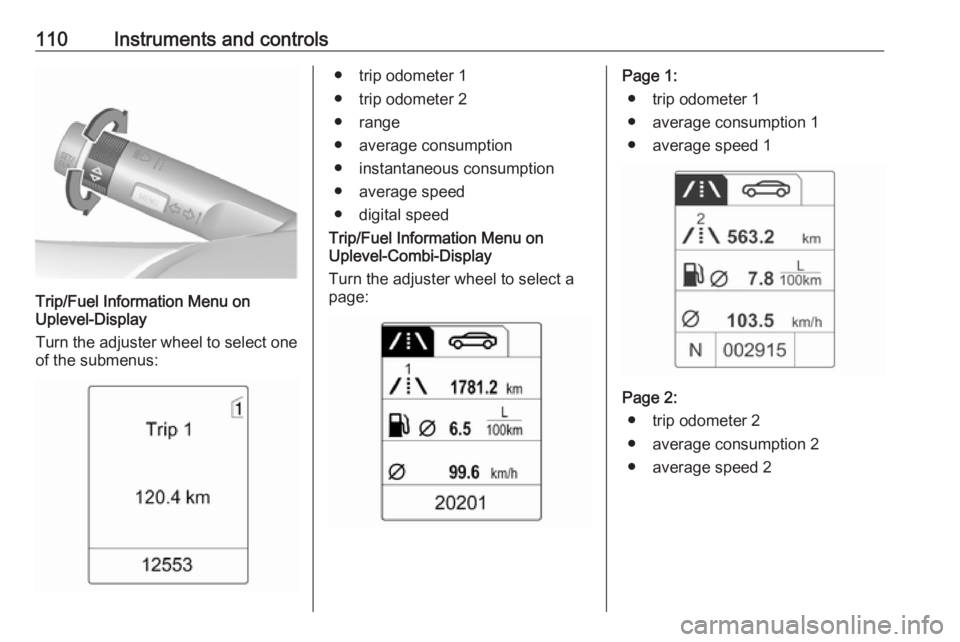
110Instruments and controls
Trip/Fuel Information Menu on
Uplevel-Display
Turn the adjuster wheel to select one of the submenus:
● trip odometer 1
● trip odometer 2
● range
● average consumption
● instantaneous consumption
● average speed
● digital speed
Trip/Fuel Information Menu on
Uplevel-Combi-Display
Turn the adjuster wheel to select a
page:Page 1:
● trip odometer 1
● average consumption 1
● average speed 1
Page 2: ● trip odometer 2
● average consumption 2
● average speed 2
Page 113 of 251
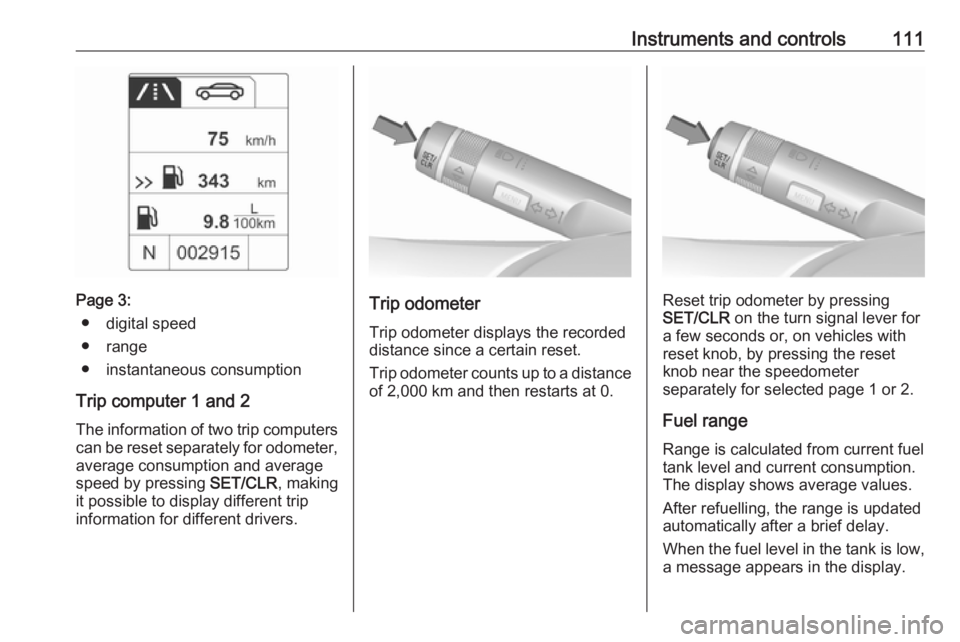
Instruments and controls111
Page 3:● digital speed
● range
● instantaneous consumption
Trip computer 1 and 2
The information of two trip computers can be reset separately for odometer, average consumption and average
speed by pressing SET/CLR, making
it possible to display different trip
information for different drivers.Trip odometer
Trip odometer displays the recorded
distance since a certain reset.
Trip odometer counts up to a distance of 2,000 km and then restarts at 0.Reset trip odometer by pressing
SET/CLR on the turn signal lever for
a few seconds or, on vehicles with
reset knob, by pressing the reset knob near the speedometer
separately for selected page 1 or 2.
Fuel range Range is calculated from current fuel
tank level and current consumption.
The display shows average values.
After refuelling, the range is updated
automatically after a brief delay.
When the fuel level in the tank is low,
a message appears in the display.
Page 114 of 251
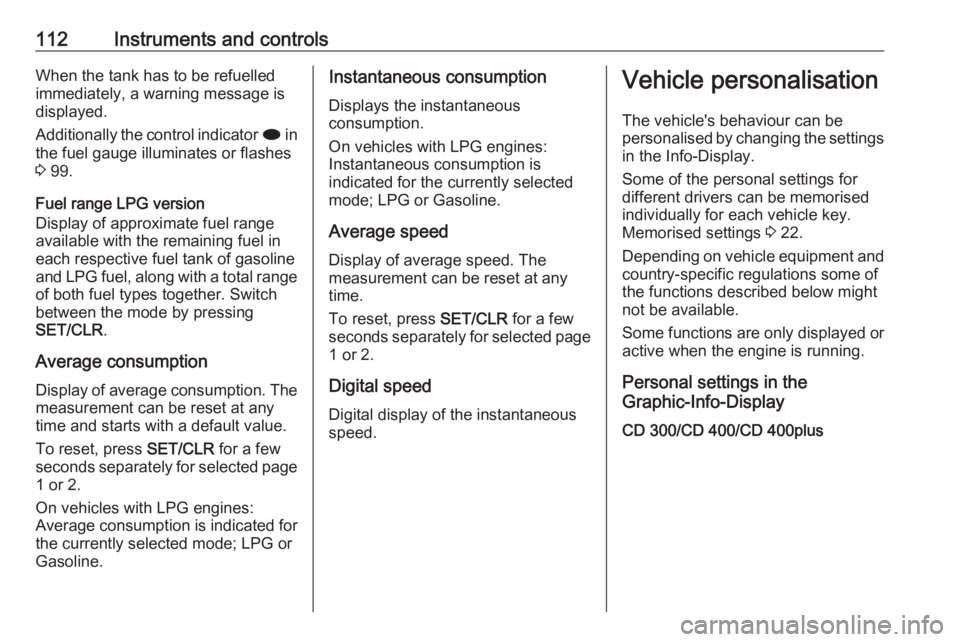
112Instruments and controlsWhen the tank has to be refuelled
immediately, a warning message is
displayed.
Additionally the control indicator i in
the fuel gauge illuminates or flashes
3 99.
Fuel range LPG version
Display of approximate fuel range
available with the remaining fuel in
each respective fuel tank of gasoline
and LPG fuel, along with a total range of both fuel types together. Switch
between the mode by pressing
SET/CLR .
Average consumption
Display of average consumption. The measurement can be reset at any
time and starts with a default value.
To reset, press SET/CLR for a few
seconds separately for selected page
1 or 2.
On vehicles with LPG engines:
Average consumption is indicated for
the currently selected mode; LPG or
Gasoline.Instantaneous consumption
Displays the instantaneous
consumption.
On vehicles with LPG engines:
Instantaneous consumption is
indicated for the currently selected mode; LPG or Gasoline.
Average speed
Display of average speed. The
measurement can be reset at any
time.
To reset, press SET/CLR for a few
seconds separately for selected page
1 or 2.
Digital speed
Digital display of the instantaneous
speed.Vehicle personalisation
The vehicle's behaviour can be
personalised by changing the settings in the Info-Display.
Some of the personal settings for
different drivers can be memorised
individually for each vehicle key.
Memorised settings 3 22.
Depending on vehicle equipment and
country-specific regulations some of the functions described below might
not be available.
Some functions are only displayed or
active when the engine is running.
Personal settings in the
Graphic-Info-Display
CD 300/CD 400/CD 400plus
Page 141 of 251
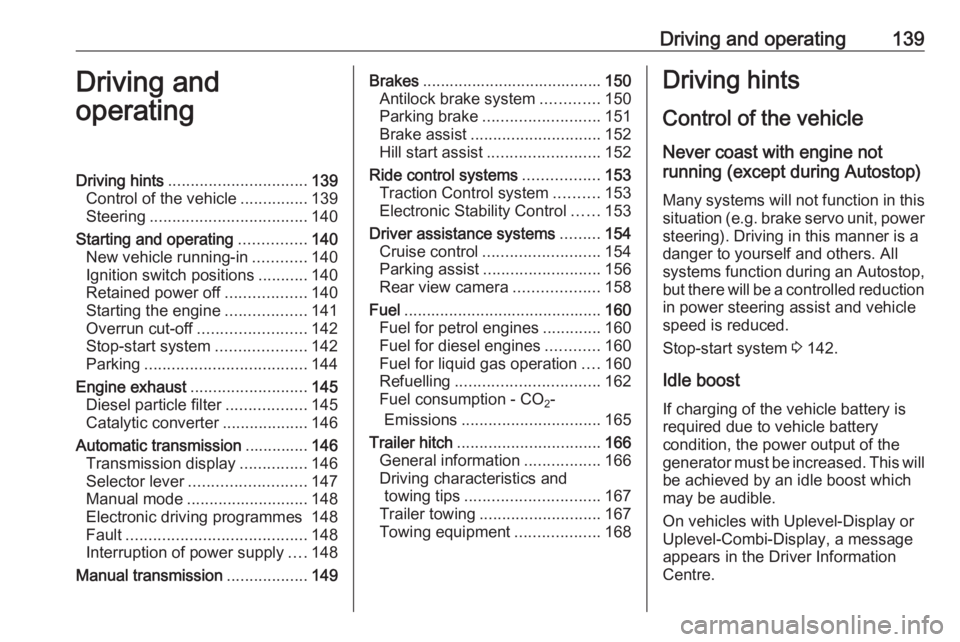
Driving and operating139Driving and
operatingDriving hints ............................... 139
Control of the vehicle ...............139
Steering ................................... 140
Starting and operating ...............140
New vehicle running-in ............140
Ignition switch positions ...........140
Retained power off ..................140
Starting the engine ..................141
Overrun cut-off ........................ 142
Stop-start system ....................142
Parking .................................... 144
Engine exhaust .......................... 145
Diesel particle filter ..................145
Catalytic converter ...................146
Automatic transmission ..............146
Transmission display ...............146
Selector lever .......................... 147
Manual mode ........................... 148
Electronic driving programmes 148
Fault ........................................ 148
Interruption of power supply ....148
Manual transmission ..................149Brakes........................................ 150
Antilock brake system .............150
Parking brake .......................... 151
Brake assist ............................. 152
Hill start assist ......................... 152
Ride control systems .................153
Traction Control system ..........153
Electronic Stability Control ......153
Driver assistance systems .........154
Cruise control .......................... 154
Parking assist .......................... 156
Rear view camera ...................158
Fuel ............................................ 160
Fuel for petrol engines .............160
Fuel for diesel engines ............160
Fuel for liquid gas operation ....160
Refuelling ................................ 162
Fuel consumption - CO 2-
Emissions ............................... 165
Trailer hitch ................................ 166
General information .................166
Driving characteristics and towing tips .............................. 167
Trailer towing ........................... 167
Towing equipment ...................168Driving hints
Control of the vehicle
Never coast with engine not
running (except during Autostop)
Many systems will not function in this
situation (e.g. brake servo unit, power steering). Driving in this manner is a
danger to yourself and others. All
systems function during an Autostop,
but there will be a controlled reduction
in power steering assist and vehicle
speed is reduced.
Stop-start system 3 142.
Idle boost
If charging of the vehicle battery is
required due to vehicle battery
condition, the power output of the
generator must be increased. This will be achieved by an idle boost whichmay be audible.
On vehicles with Uplevel-Display or
Uplevel-Combi-Display, a message
appears in the Driver Information
Centre.
Page 142 of 251
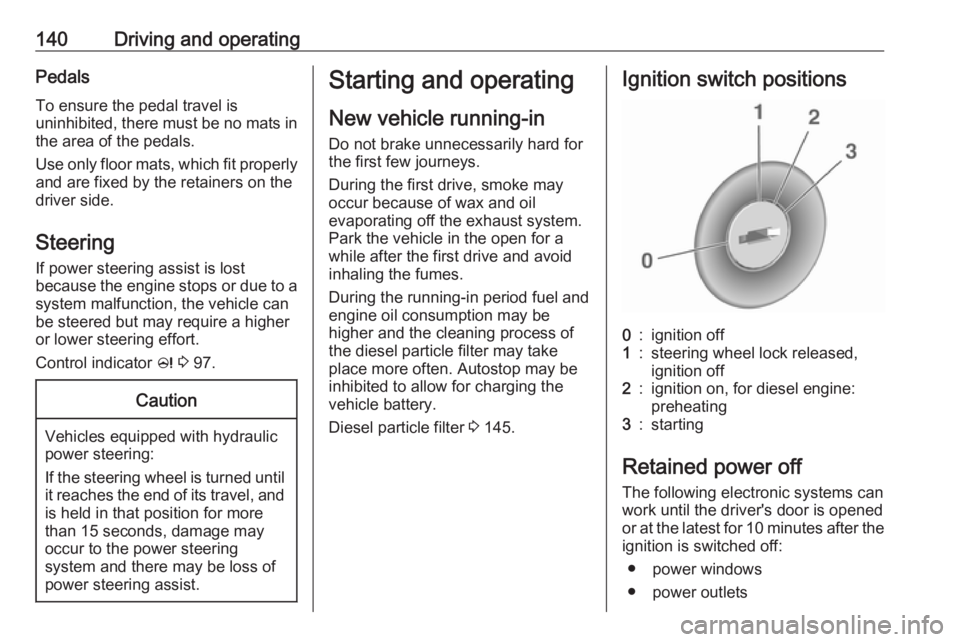
140Driving and operatingPedals
To ensure the pedal travel is
uninhibited, there must be no mats in
the area of the pedals.
Use only floor mats, which fit properly and are fixed by the retainers on the
driver side.
Steering If power steering assist is lost
because the engine stops or due to a system malfunction, the vehicle can
be steered but may require a higher
or lower steering effort.
Control indicator c 3 97.Caution
Vehicles equipped with hydraulic
power steering:
If the steering wheel is turned until it reaches the end of its travel, and
is held in that position for more
than 15 seconds, damage may
occur to the power steering
system and there may be loss of
power steering assist.
Starting and operating
New vehicle running-in
Do not brake unnecessarily hard for
the first few journeys.
During the first drive, smoke may
occur because of wax and oil
evaporating off the exhaust system.
Park the vehicle in the open for a
while after the first drive and avoid
inhaling the fumes.
During the running-in period fuel and engine oil consumption may be
higher and the cleaning process of the diesel particle filter may take
place more often. Autostop may be
inhibited to allow for charging the
vehicle battery.
Diesel particle filter 3 145.Ignition switch positions0:ignition off1:steering wheel lock released,
ignition off2:ignition on, for diesel engine:
preheating3:starting
Retained power off
The following electronic systems can
work until the driver's door is opened
or at the latest for 10 minutes after the
ignition is switched off:
● power windows
● power outlets
Page 147 of 251
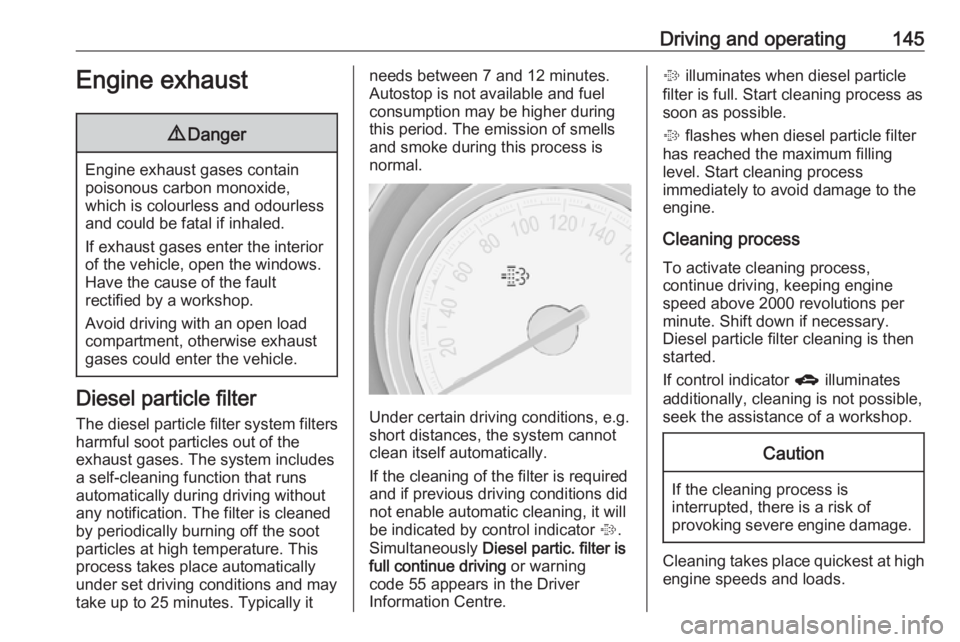
Driving and operating145Engine exhaust9Danger
Engine exhaust gases contain
poisonous carbon monoxide,
which is colourless and odourless and could be fatal if inhaled.
If exhaust gases enter the interior
of the vehicle, open the windows.
Have the cause of the fault
rectified by a workshop.
Avoid driving with an open load
compartment, otherwise exhaust
gases could enter the vehicle.
Diesel particle filter
The diesel particle filter system filters
harmful soot particles out of the
exhaust gases. The system includes
a self-cleaning function that runs
automatically during driving without
any notification. The filter is cleaned
by periodically burning off the soot
particles at high temperature. This
process takes place automatically
under set driving conditions and may
take up to 25 minutes. Typically it
needs between 7 and 12 minutes.
Autostop is not available and fuel
consumption may be higher during
this period. The emission of smells
and smoke during this process is
normal.
Under certain driving conditions, e.g.
short distances, the system cannot
clean itself automatically.
If the cleaning of the filter is required
and if previous driving conditions did
not enable automatic cleaning, it will
be indicated by control indicator %.
Simultaneously Diesel partic. filter is
full continue driving or warning
code 55 appears in the Driver
Information Centre.
% illuminates when diesel particle
filter is full. Start cleaning process as
soon as possible.
% flashes when diesel particle filter
has reached the maximum filling
level. Start cleaning process
immediately to avoid damage to the
engine.
Cleaning process To activate cleaning process,
continue driving, keeping engine
speed above 2000 revolutions per
minute. Shift down if necessary.
Diesel particle filter cleaning is then
started.
If control indicator g illuminates
additionally, cleaning is not possible,
seek the assistance of a workshop.Caution
If the cleaning process is
interrupted, there is a risk of
provoking severe engine damage.
Cleaning takes place quickest at high
engine speeds and loads.
Page 167 of 251
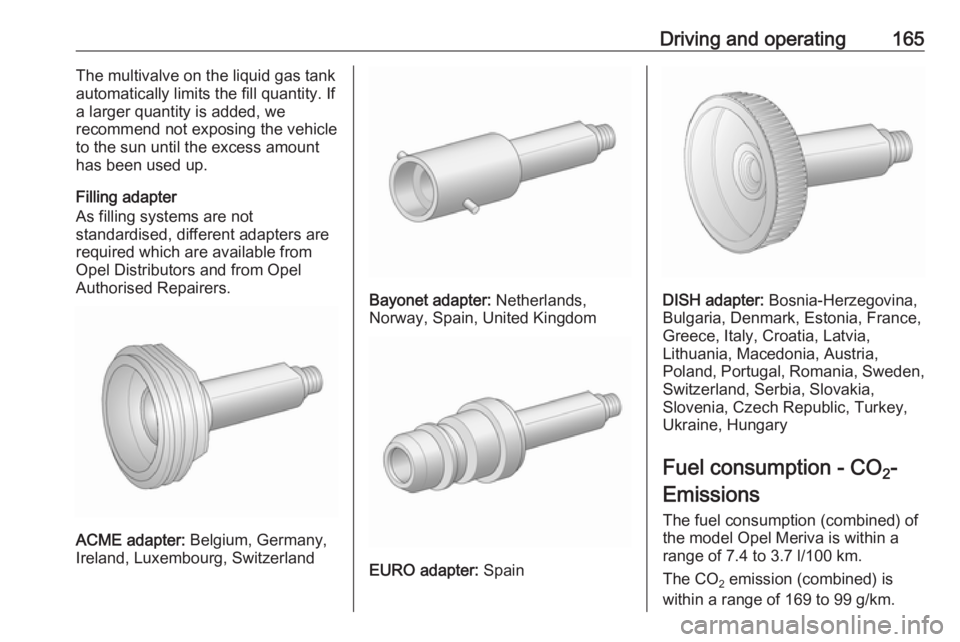
Driving and operating165The multivalve on the liquid gas tank
automatically limits the fill quantity. If
a larger quantity is added, we
recommend not exposing the vehicle
to the sun until the excess amount
has been used up.
Filling adapter
As filling systems are not
standardised, different adapters are
required which are available from
Opel Distributors and from Opel
Authorised Repairers.
ACME adapter: Belgium, Germany,
Ireland, Luxembourg, Switzerland
Bayonet adapter: Netherlands,
Norway, Spain, United Kingdom
EURO adapter: Spain
DISH adapter: Bosnia-Herzegovina,
Bulgaria, Denmark, Estonia, France,
Greece, Italy, Croatia, Latvia,
Lithuania, Macedonia, Austria,
Poland, Portugal, Romania, Sweden,
Switzerland, Serbia, Slovakia,
Slovenia, Czech Republic, Turkey,
Ukraine, Hungary
Fuel consumption - CO 2-
Emissions
The fuel consumption (combined) of
the model Opel Meriva is within a
range of 7.4 to 3.7 l/100 km.
The CO 2 emission (combined) is
within a range of 169 to 99 g/km.
Page 168 of 251
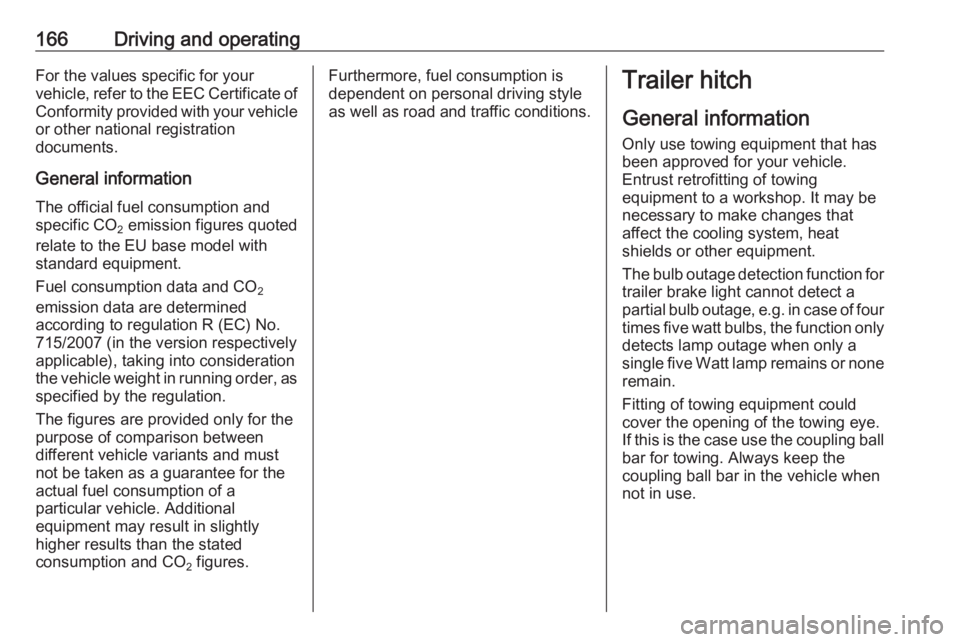
166Driving and operatingFor the values specific for your
vehicle, refer to the EEC Certificate of Conformity provided with your vehicle
or other national registration
documents.
General information
The official fuel consumption and
specific CO 2 emission figures quoted
relate to the EU base model with
standard equipment.
Fuel consumption data and CO 2
emission data are determined
according to regulation R (EC) No.
715/2007 (in the version respectively
applicable), taking into consideration
the vehicle weight in running order, as specified by the regulation.
The figures are provided only for the
purpose of comparison between
different vehicle variants and must
not be taken as a guarantee for the
actual fuel consumption of a
particular vehicle. Additional
equipment may result in slightly
higher results than the stated
consumption and CO 2 figures.Furthermore, fuel consumption is
dependent on personal driving style
as well as road and traffic conditions.Trailer hitch
General information
Only use towing equipment that has
been approved for your vehicle.
Entrust retrofitting of towing
equipment to a workshop. It may be
necessary to make changes that
affect the cooling system, heat
shields or other equipment.
The bulb outage detection function for
trailer brake light cannot detect a
partial bulb outage, e.g. in case of four times five watt bulbs, the function only
detects lamp outage when only a
single five Watt lamp remains or none remain.
Fitting of towing equipment could
cover the opening of the towing eye.
If this is the case use the coupling ball
bar for towing. Always keep the
coupling ball bar in the vehicle when
not in use.
Page 199 of 251
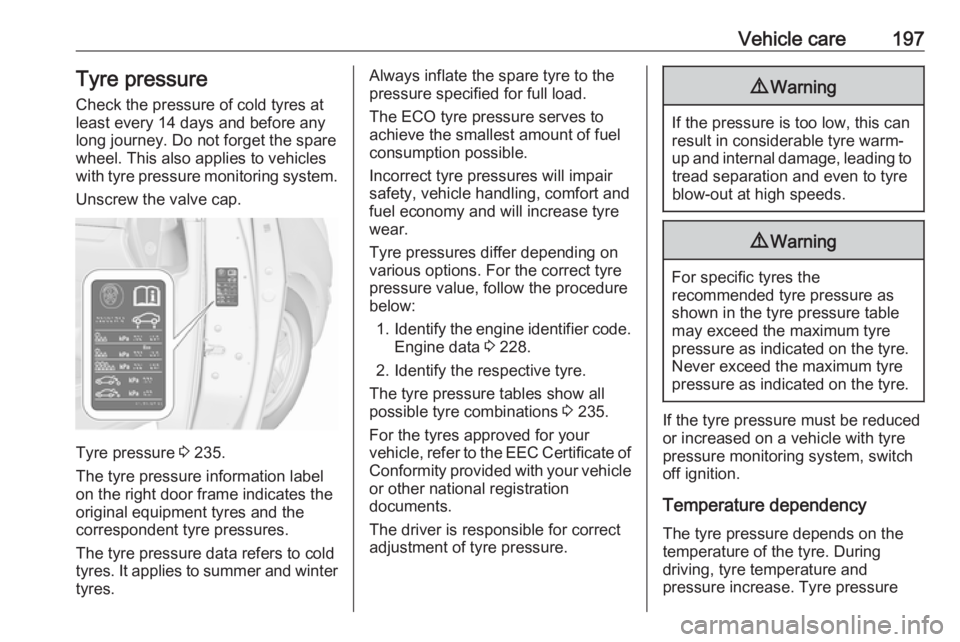
Vehicle care197Tyre pressure
Check the pressure of cold tyres at least every 14 days and before any
long journey. Do not forget the spare
wheel. This also applies to vehicles
with tyre pressure monitoring system.
Unscrew the valve cap.
Tyre pressure 3 235.
The tyre pressure information label
on the right door frame indicates the original equipment tyres and the
correspondent tyre pressures.
The tyre pressure data refers to cold
tyres. It applies to summer and winter tyres.
Always inflate the spare tyre to the
pressure specified for full load.
The ECO tyre pressure serves to
achieve the smallest amount of fuel
consumption possible.
Incorrect tyre pressures will impair
safety, vehicle handling, comfort and
fuel economy and will increase tyre
wear.
Tyre pressures differ depending on
various options. For the correct tyre
pressure value, follow the procedure
below:
1. Identify the engine identifier code.
Engine data 3 228.
2. Identify the respective tyre.
The tyre pressure tables show all
possible tyre combinations 3 235.
For the tyres approved for your
vehicle, refer to the EEC Certificate of Conformity provided with your vehicle
or other national registration
documents.
The driver is responsible for correct adjustment of tyre pressure.9 Warning
If the pressure is too low, this can
result in considerable tyre warm-
up and internal damage, leading to tread separation and even to tyre
blow-out at high speeds.
9 Warning
For specific tyres the
recommended tyre pressure as
shown in the tyre pressure table may exceed the maximum tyre
pressure as indicated on the tyre.
Never exceed the maximum tyre
pressure as indicated on the tyre.
If the tyre pressure must be reduced
or increased on a vehicle with tyre
pressure monitoring system, switch
off ignition.
Temperature dependency
The tyre pressure depends on the
temperature of the tyre. During
driving, tyre temperature and
pressure increase. Tyre pressure
Page 247 of 251
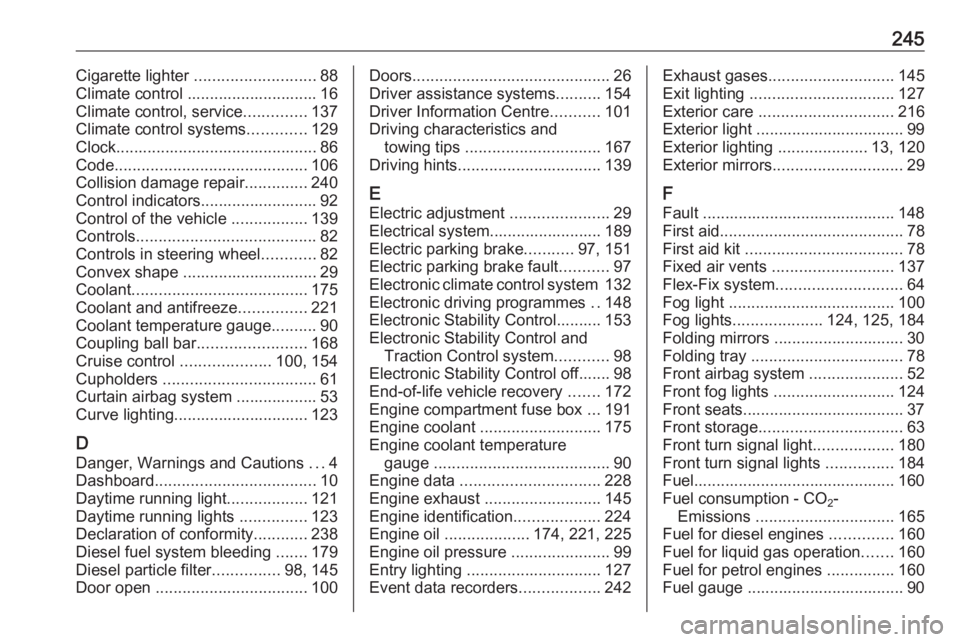
245Cigarette lighter ........................... 88
Climate control ............................. 16
Climate control, service ..............137
Climate control systems .............129
Clock............................................. 86
Code ........................................... 106
Collision damage repair ..............240
Control indicators.......................... 92
Control of the vehicle .................139
Controls ........................................ 82
Controls in steering wheel ............82
Convex shape .............................. 29
Coolant ....................................... 175
Coolant and antifreeze ...............221
Coolant temperature gauge ..........90
Coupling ball bar ........................168
Cruise control ....................100, 154
Cupholders .................................. 61
Curtain airbag system .................. 53
Curve lighting.............................. 123
D
Danger, Warnings and Cautions ...4
Dashboard .................................... 10
Daytime running light ..................121
Daytime running lights ...............123
Declaration of conformity ............238
Diesel fuel system bleeding .......179
Diesel particle filter ...............98, 145
Door open .................................. 100Doors............................................ 26
Driver assistance systems ..........154
Driver Information Centre ...........101
Driving characteristics and towing tips .............................. 167
Driving hints ................................ 139
E Electric adjustment ......................29
Electrical system......................... 189
Electric parking brake ...........97, 151
Electric parking brake fault ...........97
Electronic climate control system 132
Electronic driving programmes ..148
Electronic Stability Control.......... 153
Electronic Stability Control and Traction Control system ............98
Electronic Stability Control off....... 98
End-of-life vehicle recovery .......172
Engine compartment fuse box ...191
Engine coolant ........................... 175
Engine coolant temperature gauge ....................................... 90
Engine data ............................... 228
Engine exhaust .......................... 145
Engine identification ...................224
Engine oil ................... 174, 221, 225
Engine oil pressure ......................99
Entry lighting .............................. 127
Event data recorders ..................242Exhaust gases ............................ 145
Exit lighting ................................ 127
Exterior care .............................. 216
Exterior light ................................. 99
Exterior lighting ....................13, 120
Exterior mirrors ............................. 29
F
Fault ........................................... 148
First aid ......................................... 78
First aid kit ................................... 78
Fixed air vents ........................... 137
Flex-Fix system ............................ 64
Fog light ..................................... 100
Fog lights .................... 124, 125, 184
Folding mirrors ............................. 30
Folding tray .................................. 78
Front airbag system .....................52
Front fog lights ........................... 124
Front seats.................................... 37
Front storage ................................ 63
Front turn signal light ..................180
Front turn signal lights ...............184
Fuel............................................. 160
Fuel consumption - CO 2-
Emissions ............................... 165
Fuel for diesel engines ..............160
Fuel for liquid gas operation .......160
Fuel for petrol engines ...............160
Fuel gauge ................................... 90